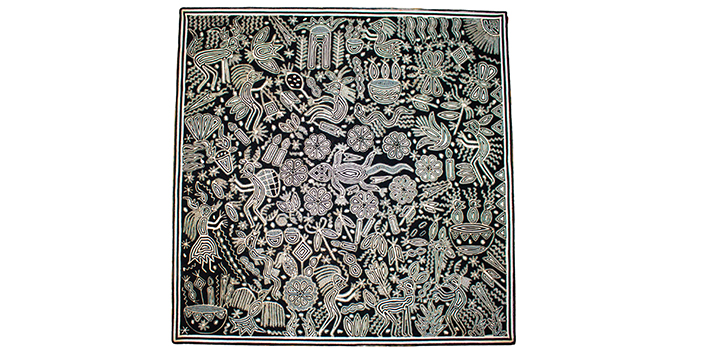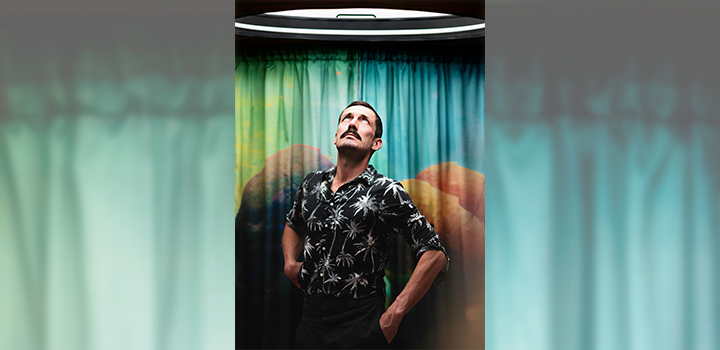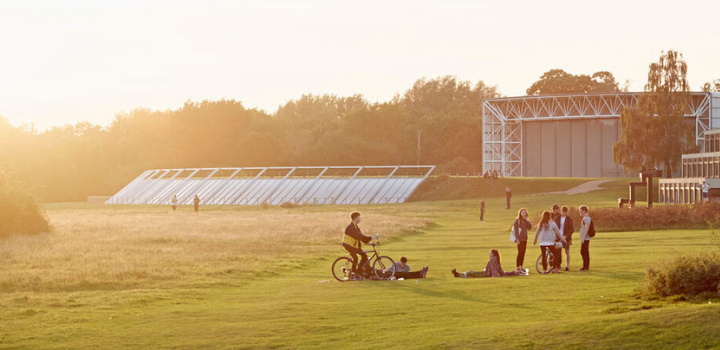New season at the Sainsbury Centre asks Why Do We Take Drugs?
By: Communications

In September 2024, the Sainsbury Centre will address its next big question through a six-month season of interlinked exhibitions and programmes exploring Why Do We Take Drugs?
From alcohol and caffeine to ayahuasca and heroin, this season uses art to take visitors on a journey of investigation, inviting audiences to explore the world of global drug cultures from illegal to familiar across one museum landscape.
Substances are taken in every culture around the world, spanning a huge range of experiences for the human body. Drugs pervade society: creating shared experiences that bind people together and also fuelling individual addictions that tear communities apart. Art and artists help us explore and better understand this world of drugs across time and space. They help us to question whether there is a right way to manage their use in society. When and why are some drugs socially accepted, whilst others are not?
The season explores both the organised and chaotic use of narcotics and intoxicants within communities in different parts of the world alongside the human stories, experiences and cultural impact of mind-altering substances.
Dr Jago Cooper, director of the Sainsbury Centre, says: “I think museums need to help people answer the most important questions in our society and taking drugs is a fundamental one. Drugs exist in every society and the role they play is huge. These incredible exhibitions from around the world take visitors over the highs and lows of that reality and their impact in so many people’s lives around the globe.”
“We are so grateful to the incredible range of friends and collaborators from around the world who are bringing their incredible practice and experiences to a new audience at the Sainsbury Centre. Visitors will be in for a mind-blowing experience.”
Power Plants: Intoxicants, Stimulants and Narcotics
14 September 2024 – 2 February 2025 
Image: Sara Flores, Untitled (Maya Kené 15, 2023), 2023, Vegetal dyes on wild-cotton canvas 51 5/8 x 90 11/16 in. (131.1 x 230.3 cm) © the artist. Photo © White Cube (Ollie Hammick)
From peyote to tobacco, for millennia people have used the psychoactive properties of plants as an integral part of social, ceremonial and religious life.
In many parts of the world, plants of power – whether this be spiritual, economic, mind-altering or cultural – are regarded as sacred. They are valued for their capacity to deepen human relationships, facilitate communication with ancestors, and heal the sick.
Power Plants: Intoxicants, Stimulants and Narcotics will feature objects, sculpture, yarn paintings, digital works, textiles, plus a selection of Japanese art, to explore the important role that stimulants and intoxicants continue to perform within societies.
The show will reference global artefacts that are connected with the traditional consumption of tobacco and snuff, betel nut, kava, tea and palm wine, alongside an exploration of the sacred, hallucinogenic cactus, peyote. The exhibition will show works by contemporary artists such as South African artist Sethembile Msezane (b.1991) and Mexican artist Guadalupe Muñoz (b.1974) and feature newly commissioned work from Togolese-British artist Divine Southgate-Smith (b.1995).
The green tea section, set out as a tearoom for a ceremony, will be curated by Mr Yasuhiro Yamaguchi, a Urasenke School tea ceremony practitioner and teacher.
Ayahuasca & Art of the Amazon
14 September 2024 – 2 February 2025

Unknown artist, jar, Shipibo-Konibo, Peru, date unknown, painted terra-cotta. Courtesy of private collection
This exhibition considers the impact of the mind-altering, psychotropic vine – ayahuasca – within Western Amazonian social life.
From the 1950s onwards, drugs were heavily linked with the emergence of the American literary and social movement of the Beat Generation. Artworks produced in North America and Europe speak to the ways in which hallucinogens are transforming the cultural landscape, becoming important for political emancipation, psychotherapy, and personal development.
In many Indigenous societies, hallucinogens continue to play a role in the determination of social position, therapeutic practices, and the maintenance of relationships with ancestors, spirits, and gods. And now, because of the boom in international tourism, increasing amounts of people are now experiencing the effects of ayahuasca.
Ayahuasca & Art of the Amazon will show that the ritual consumption of ayahuasca is intimately linked to the artistic production of ceramics, textiles, sculpture, painting and photography.
The exhibition focuses on the creativity of Indigenous artists of the Peruvian Amazon’s Shipibo-Konibo community, presenting historical artefacts alongside contemporary works by living artists.
Ayahuasca & Art of the Amazon is a rare opportunity to appreciate the breadth of Amazonian art, which ranges from the mesmerising abstract geometrical patterns known as ‘kené’ to figurative portrayals of Amazonian cosmologies and spiritual encounters.
Visitors will also be able to take a virtual ‘trip’ on an ayahuasca journey – guided by a shaman – thanks to a powerful VR experience.
The exhibition will also feature an extended replica of Brion Gysin and Ian Sommerville’s Dreamachine, first created in 1959. Intended to be viewed with your eyes closed, Gysin described the artwork as a “drugless psychedelic experience”. A perforated cylinder turning around a light source, the stroboscopic machine creates a pulsing light that will cause you to hallucinate and see changing colours and patterns behind your shut eyelids.
This exhibition was developed by the musée du quai Branly – Jacques Chirac in Paris.
Heroin Falls
23 November 2024 – 27 April 2025
Image: L-R: Lindokuhle Sobekwa, Thabang waking up in the early hours of the morning, 2015, from the Nyaope project. Copyright: Lindokuhle Sobekwa / Magnum Photos Graham MacIndoe, My Addiction. Copyright: Graham MacIndoe.
Heroin Falls highlights the realities of heroin addiction through the juxtaposition of two different worlds through the eyes of two incredible photographers.
The exhibition aims to show connections which will lead viewers to acknowledge substance misuse is a global challenge that transcends race, location and class.
Magnum photographer Lindokuhle Sobekwa (b.1995) aims his lens at a group of young men from a South African township Thokoza whom have turned to using nyaope. Nyaope is a low-grade form of heroin which can be mixed with many different bulking agents including cannabis products, antiretroviral drugs, as well as other materials. Sobekwa documents their journey, capturing their daily activities and chores, whilst part two of his project is redemptive, focusing on rehab and introspection.
Sobekwa will also carry out an artist residency in Norwich to develop his practice and engage with local communities.
Most documentary projects about addiction expose someone else's self-destructive behaviour, but Scottish born, New York based photographer Graham MacIndoe (b.1963) took a very different approach: he photographed himself during the years he was addicted to heroin. He'd place a cheap digital camera on a table or bookshelf, set the self-timer to take a photo every so often, then turn his attention to the rituals of his habit. The resulting photographs document the harsh realities of drug addiction and the photographer’s use of the artistic medium in his own recovery.
Lindsey Mendick: Hot Mess
23 November 2024 – 27 April 2025 
Image: Lindsey Mendick, SH*TFACED at Jupiter Artland, 2023. Installation View. Copyright: Lindsey Mendick. Image: by John Mackenzie
Lindsey Mendick (b.1987) subverts the tradition of ceramics with her darkly comic, confessional works. Her newly commissioned sculptures for the Sainsbury Centre will be strikingly personal, tackling social taboos and exposing the artist’s secret fears.
For the Why Do We Take Drugs? season, Mendick will reveal her reliance on antidepressants and alcohol, used to navigate stressful social situations and cope with the threatening unpredictability of daily life. Mendick’s subversive practice candidly addresses the stigma attached to the use of certain medications, such as antidepressants.
Positioning her works amongst paintings by Francis Bacon and Leonora Carrington and sculpture from the Arctic to Africa, Mendick will create a surprising intervention in the Sainsbury Centre’s ‘Living Area’ collection display to disrupt the clean aesthetic like a wild and unwelcome guest at a party.
Sculpture Park Commission
Ivan Morison: Towards the Weird Heart of Things
October 2024 – February 2025
Image: Ivan Morison. Image: Charles Emerson
The Sainsbury Centre, in collaboration with Orleans House Gallery, presents Towards the Weird Heart of Things, a new site-specific series of sculptures by artist Ivan Morison.
The commissioned work features sculptures constructed from abundant agricultural organic materials such as hemp, straw, hay, and sheep's wool, and timber. These materials, sourced from the seasonal harvest of East Anglian farms and combined with natural binders like lime and clay, give the sculptures a haystack-like appearance.
These evolving four-meter-high sculptures in the Sainsbury Centre Sculpture Park will change colour, transform, or decay and compost over time.
At the heart of this commission is an ‘eco-wakening’ – to inspire hope and point us to the fact that fatal risk of anthropogenic climate change can be avoided if we collectively focus on taking climate action and finding innovative solutions.
Towards the Weird Heart of Things is co-commissioned by Orleans House Gallery and will travel there in March, for their Cultural Reforesting strand of programming, which invites artists to explore the question How do we renew our relationship with nature
Related Articles

Overlooked hydrogen emissions are heating Earth and supercharging methane
Rising global emissions of hydrogen over the past three decades have amplified the impact of the greenhouse gas methane and intensified climate change - according to an international team including researchers at the University of East Anglia (UEA).
Read more
AI video translation shows promise but humans still hold the edge
AI video translation is not yet a perfect substitute for human translation, according to new research from the University of East Anglia (UEA).
Read more
UEA in 2025: Our year in stories
As 2025 draws to a close, join us for our annual round-up of stories and discover 20 standout moments that defined the year – from inspiring student journeys and heartfelt reunions to rare wildlife discoveries and groundbreaking research.
Read more